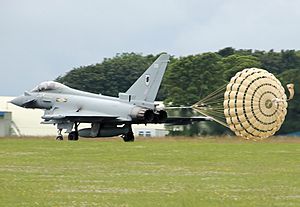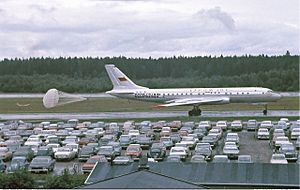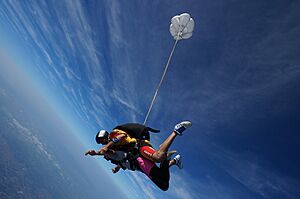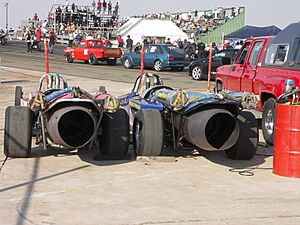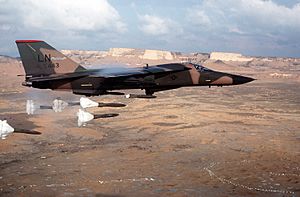Drogue parachute facts for kids
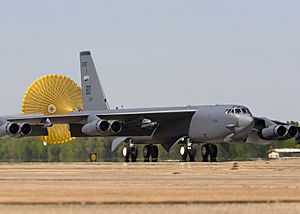
A drogue parachute, also known as a drag chute, is a special type of parachute. It's made to open when an object is moving very fast. People use it for different reasons. It can help slow things down, keep them steady, or even pull out a bigger parachute. You can find drogue parachutes on many things. These include multi-stage parachutes, airplanes, and even spacecraft that are returning to Earth.
A Russian professor and parachute expert named Gleb Kotelnikov invented the drogue parachute in 1912. He also invented the knapsack parachute. The Soviet Union started using these parachutes on some of their airplanes in the mid-1930s. Their use became more common during and after Second World War. Many jet-powered airplanes have drogue parachutes. Examples include the Boeing B-52 Stratofortress bomber and the Eurofighter Typhoon aircraft. They were also very important for spacecraft recovery. This includes missions like Project Mercury and Project Gemini. Drogue parachutes are also used on ejection seats. They help slow down and stabilize the seat after a pilot ejects.
Contents
The Story of Drogue Parachutes
The first time a drogue parachute was used was in 1912. It was part of a ground test, not from an airplane. The Russian inventor Gleb Kotelnikov did this test. He had already patented an early type of parachute that packed into a canister. On a road near Tsarskoye Selo (now part of St. Petersburg), Kotelnikov showed how the parachute could slow things down. He sped up a Russo-Balt car to its fastest speed. Then, he opened a parachute attached to the back seat. It worked to brake the car.

In 1937, the Soviet Union decided to use drogue parachutes on some airplanes. These planes were used in the Arctic. They helped supply famous polar expeditions, like the North Pole-1 ice station. This station was launched that same year. The drogue parachute helped planes land safely on smaller ice floes. Without them, these landing spots would have been too difficult.
One of the first military jet planes to use a drogue parachute was the Arado Ar 234. This was a jet-powered reconnaissance-bomber used by the Luftwaffe. Both early test versions and later production models had a drogue parachute. It was stored in the very back of the plane's belly.
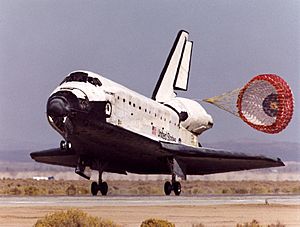
During the space race between the United States and the Soviet Union, drogue parachutes became very important. They were used on many spacecraft. All human space programs by NASA and the Soviets used them. This included Project Mercury and the Apollo program. Drogue parachutes helped recover the spacecraft along with larger main parachutes. NASA had a big budget then. This allowed them to develop advanced parachutes. These drogues could open in extreme conditions. They were even useful for missions to other planets. The Space Shuttle also used a drag chute when it landed on a runway. Its solid rocket boosters were also recovered with drogue parachutes.
What Makes Them Special?
A drogue parachute looks different from a regular parachute. It is longer and has a much smaller surface area. This means it creates less air resistance. Drogue parachutes can be opened at speeds that would tear apart normal parachutes. However, they won't slow an object down as much as a regular parachute would. Because they are simpler, drogue parachutes are also easier to open. This reduces the chance of them getting tangled or not opening correctly.
How Drogue Parachutes Are Used
Helping Parachutists
Sometimes, drogue parachutes are used to pull out a main or reserve parachute. The drag from the drogue pulls the larger parachute from its container. When used this way for a single person, it's called a pilot chute. A pilot chute only deploys the main parachute. It doesn't slow down the skydiver or provide stability. Tandem skydiving systems are a bit different. A drogue is opened soon after leaving the aircraft. This helps reduce the speed of the two jumpers during freefall. Later, it's used to deploy the main parachute, just like for single skydivers.
Many improvements have been made to drogue parachutes for this purpose. For example, a patent for a feature to prevent spinning was granted in 1972. Also, better ways to spread out the forces were developed in 2011.
Slowing Things Down Fast!
When a drogue chute helps an airplane land shorter, it's called a drag parachute or braking parachute. They work well for landings on wet or icy runways. They are also useful for high-speed emergency landings.
Braking parachutes are also used to slow down cars in drag racing. The National Hot Rod Association requires them on all vehicles that can go 150 miles per hour or faster. They have also been put on many experimental vehicles. These vehicles try to set land speed records.
Keeping Things Steady in Flight
Drogue parachutes can also help keep flying objects stable. This includes things like thrown anti-tank grenades or air-dropped bombs. Special parachutes are used to help planes recover from a stall. This helps prevent dangerous spins during airworthiness flight testing. Drogue parachutes have also been used with some large bombs. They slow the bomb's fall. This gives the aircraft that dropped it enough time to fly away safely. Drogue parachutes are used on ejection seats. They help stabilize and slow down the seat right after it's deployed. The ACES II escape system is one example. Similarly, some escape capsules, used on fast aircraft and spacecraft, use drogue parachutes. They provide both stability and braking. This allows a main parachute to open or the pilot to leave the capsule.
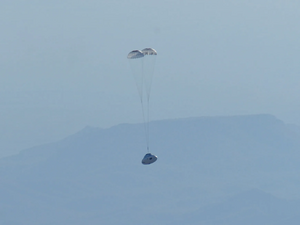
Drogue parachutes are still a very important technology for spaceflight. They help control very fast descents. This includes spacecraft coming back into Earth's atmosphere. They are usually deployed first. This helps set the right conditions for the main parachutes to open. Or, they help prepare for retropropulsion (using rockets to slow down). Examples include the Boeing X-37 spaceplane and SpaceX Dragon capsules. They are also used on Rocket Lab Electron first stages and ISRO's Gaganyaan modules. The Chang'e 5 re-entry craft also used one. The Stardust and OSIRIS-REx sample return capsules used supersonic drogue parachutes. All successful Mars landing missions as of January 2024 also used them. Some high-altitude rockets use drogue chutes too. They are part of a system that later deploys a main parachute to control and slow their descent.
See also
 In Spanish: Paracaídas de frenado para niños
In Spanish: Paracaídas de frenado para niños
- Air brake (aircraft)
- Drogue
- Sea anchor


